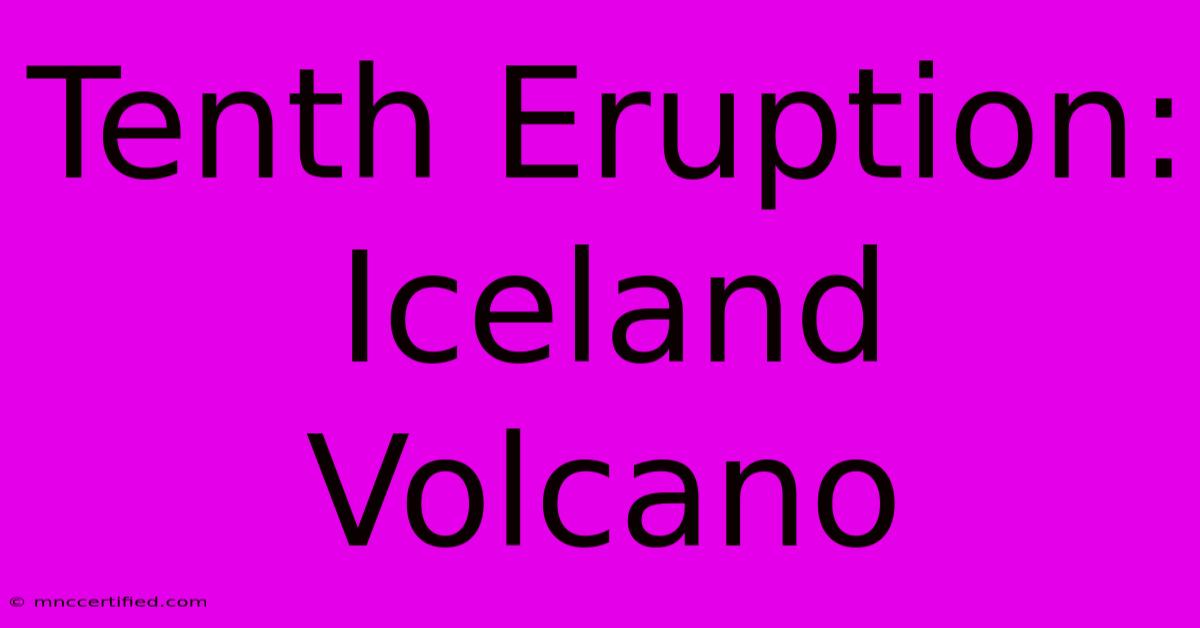Tenth Eruption: Iceland Volcano

Table of Contents
Tenth Eruption: Iceland Volcano – A Deep Dive into Fagradalsfjall's Ongoing Activity
Iceland, the land of fire and ice, has once again captivated the world with volcanic activity. While Iceland experiences frequent eruptions, the ongoing activity at Fagradalsfjall volcano marks a significant event, representing the tenth eruption in a series that began in 2021. This article will delve into the details of this fascinating geological phenomenon, examining its impact, scientific significance, and the ongoing monitoring efforts.
Understanding the Fagradalsfjall Eruption Series
The current eruption at Fagradalsfjall is not an isolated event. It's part of a series of eruptions that commenced in March 2021, significantly impacting the Reykjanes Peninsula. This area, known for its volcanic activity, has seen a dramatic increase in seismic activity in recent years, preceding these eruptions. This series of eruptions presents a unique opportunity for volcanologists to study effusive eruptions – those characterized by the outpouring of lava, rather than explosive pyroclastic flows.
The Significance of the Tenth Eruption
The tenth eruption, while not as visually spectacular as some previous ones, offers valuable insights into the volcano's long-term behavior and the dynamics of the Reykjanes Peninsula's volcanic system. Scientists are closely monitoring:
- Lava flow patterns: Analyzing the direction and speed of lava flows helps predict potential hazards and informs evacuation plans.
- Gas emissions: Monitoring sulfur dioxide (SO2) and other gases provides crucial data on the eruption's intensity and potential environmental impact.
- Seismic activity: Continuous monitoring of earthquakes helps understand the magma movement beneath the surface and predict future activity.
These data points are crucial for refining volcanic hazard assessments and improving the safety of nearby communities. The long duration of the eruption series also allows for long-term studies on the evolution of lava flows, the formation of new land, and the ecological recovery of the affected area.
The Impact and Safety Measures
While the effusive nature of the Fagradalsfjall eruptions generally poses less of an immediate threat to human life than explosive eruptions, safety measures remain crucial. Authorities have implemented strict access restrictions, limiting access to the eruption site to ensure public safety. Hazard zones are clearly defined, and visitors are urged to adhere to official guidelines and warnings. The ongoing monitoring provides real-time data, allowing for timely adjustments to safety protocols.
The impact on the environment is also being closely scrutinized. While lava flows can dramatically alter landscapes, the relatively low explosivity of these eruptions means the environmental impact is primarily local. However, air quality monitoring is essential, particularly concerning SO2 emissions, to assess any potential respiratory risks for nearby communities.
Scientific Importance and Future Research
The Fagradalsfjall eruption series provides an unparalleled opportunity for scientific research. Volcanologists are using a variety of sophisticated techniques, including drone surveys, satellite imagery, and ground-based measurements, to study:
- Magma composition: Analyzing the chemical composition of the lava helps understand the source of the magma and the processes within the Earth's mantle.
- Lava flow dynamics: Studying the behavior of lava flows helps improve models for predicting future eruptions and assessing hazards.
- Geological evolution: The ongoing eruption allows for real-time observation of the formation of new geological features and the long-term evolution of the landscape.
The data gathered from this ongoing research will contribute significantly to our understanding of volcanic processes and improve our ability to forecast and mitigate volcanic hazards globally.
Conclusion: A Continuing Story
The tenth eruption at Fagradalsfjall volcano is not just another event; it’s a testament to the dynamic nature of Iceland's geological landscape and a continuing source of fascination and scientific investigation. The ongoing monitoring and research efforts provide invaluable insights into volcanic processes, improving our understanding and preparedness for future volcanic events. This series of eruptions, therefore, serves as a crucial case study for volcanologists worldwide, shaping future strategies for volcano monitoring and hazard management. Remember to always consult official sources for up-to-date information and safety guidelines regarding the Fagradalsfjall eruptions.

Thank you for visiting our website wich cover about Tenth Eruption: Iceland Volcano. We hope the information provided has been useful to you. Feel free to contact us if you have any questions or need further assistance. See you next time and dont miss to bookmark.
Featured Posts
-
Controversial Jaguar Rebrand Public Reaction
Nov 21, 2024
-
Great Southern Life Insurance Co
Nov 21, 2024
-
National Insurance Scheme Guyana
Nov 21, 2024
-
17 65 An Hour Is How Much A Year
Nov 21, 2024
-
Russias Invasion Ukraine Live Updates
Nov 21, 2024